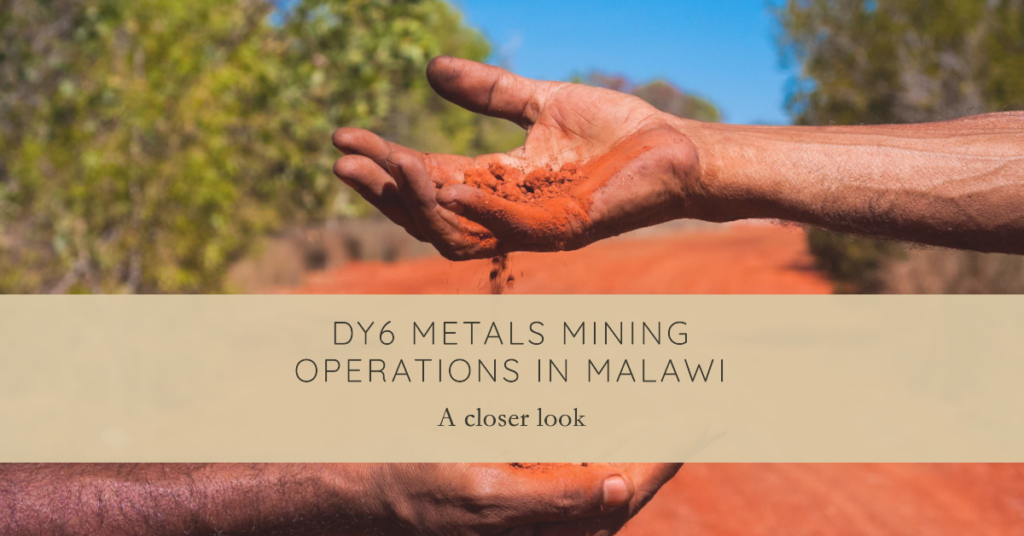Given DY6 Metals’ upcoming listing on the ASX, we should take a closer look at their operations in Malawi:
DY6 Metals, upon listing on the ASX, will possess three promising projects
The projects in Southern Malawi are focused on Heavy Rare Earths and Critical Metals. These projects are located in a proven region known for hosting economically viable Rare Earth Element (REE) deposits. Understanding the expected returns and risks associated with these projects is crucial for potential investors. Let’s delve into each project and its characteristics.
- Machinga HREEs & Nb-Ta-Zr Project: The Machinga Project is rich in Heavy Rare Earth Elements (HREEs) as well as Niobium (Nb), Tantalum (Ta), and Zirconium (Zr). The project’s potential is demonstrated by the results from previous drilling:
- MARC005: This drill hole intercepted 11 meters of mineralization containing 1.0% Total Rare Earth Oxide (TREO) with 330 parts per million (ppm) of Dysprosium Oxide (Dy2O3). Notably, within this intercept, there is a 4-meter section with 1.4% TREO and 492 ppm Dy2O3.
- MARC015: This drill hole intersected 5 meters of mineralization with 1.5% TREO and 596 ppm Dy2O3. Furthermore, within this interval, there is a 1-meter section with 2.5% TREO and 971 ppm Dy2O3.
These results indicate the presence of high-grade mineralization at Machinga, highlighting the potential for substantial returns on investment.
- Salambidwe REE Nb-Ta Project: The Salambidwe Project focuses on Rare Earth Elements (REEs), Niobium (Nb), and Tantalum (Ta). Rock chip sampling has provided encouraging results, including samples with 2.05% TREO and 214 ppm Dy2O3. These findings suggest the presence of significant mineralization, indicating the potential for favorable returns.
- Ngala PGE Project: The Ngala Project primarily targets Platinum Group Elements (PGEs) such as Palladium (Pd), Platinum (Pt), and Gold (Au), along with Copper (Cu). Initial sampling has identified values of up to 4.0 grams per tonne (g/t) of Pd+Pt+Au and 0.7% Cu. These results indicate the presence of valuable mineralization, which could yield favorable returns.
Key Project Characteristics:
- High-grade historical drilling and workings: The projects benefit from previous drilling efforts and mining activities, suggesting the presence of known mineralized zones.
- Significant underexplored potential: Despite the historical activities, there is still considerable room for exploration and the potential to identify new mineralized zones. This aspect presents an opportunity for investors to tap into unexplored resources.
- Focus on historical REE drill results: The initial exploration efforts will prioritize the areas with significant historical REE drill results. This strategy allows DY6 Metals to build upon existing knowledge and target areas with higher potential for mineralization.
- Drill-ready targets and planned drilling: DY6 Metals has identified drill-ready targets in the Machinga Main Zone. They plan to conduct up to 5,000 meters of drilling following the listing, further advancing the understanding of the projects’ potential and de-risking the investment.
Risks and Considerations:
Investing in mineral exploration projects carries inherent risks, including but not limited to:
- Geological uncertainties: Despite promising historical results, the presence and extent of mineralization cannot be guaranteed, and geological risks should be considered.
- Market volatility: The financial success of mining projects is influenced by market conditions, commodity prices, and demand for the targeted minerals. These factors can impact the potential returns on investment.
- Regulatory and operational challenges: Mining projects are subject to various regulatory requirements, environmental considerations, and operational complexities that can affect the project’s feasibility and profitability.
Think about Malawi
DY6 Metals’ projects in Southern Malawi offer potential investors an opportunity to tap into Heavy Rare Earths, Critical Metals, and Platinum Group Elements in a proven mineralized region. The presence of high-grade mineralization, historical data, and planned drilling activities contribute to the attractiveness of these projects. However, it is essential for investors to conduct thorough due diligence, considering geological uncertainties, market dynamics, and regulatory factors. By carefully assessing the expected returns and associated risks, potential investors can make informed decisions regarding their participation in DY6 Metals’ ventures.
Malawi, a landlocked country in southeastern Africa, stands out as a relatively stable jurisdiction for rare earth extraction compared to some of the world’s leading rare earth mining locales. The country’s political and regulatory environment offers a favorable contrast, providing potential investors with a sense of stability and security.
Political Stability
Malawi has enjoyed a relatively stable political climate in recent years. The country has a democratic system of government with regular elections and a peaceful transition of power. The commitment to democratic principles and the rule of law contributes to a stable investment environment. The government’s focus on economic growth and attracting foreign investment further enhances the stability of the country.
Regulatory Environment
Malawi’s regulatory framework for mining and resource extraction is relatively transparent and investor-friendly. The government has enacted legislation to promote responsible mining practices, protect the environment, and ensure the equitable distribution of benefits from mineral resources. The Mining Act provides a clear legal framework for licensing, exploration, and mining operations, which contributes to regulatory stability and predictability for investors.
Investment Incentives
The Malawian government has implemented various incentives to attract foreign direct investment in the mining sector. These incentives include tax holidays, customs duty exemptions on imported mining equipment, and the facilitation of access to financing and infrastructure development. Such measures aim to create a conducive environment for investors, reducing barriers and risks associated with establishing and operating mining projects.
Contrast with Leading Rare Earth Extraction Locales
In contrast, some of the world’s leading rare earth extraction locales face notable political and regulatory challenges. For example:
- China: China currently dominates the rare earth market, accounting for a significant portion of global production. However, the Chinese government tightly controls the industry through export quotas and restrictive regulations. This creates uncertainty for international investors and can result in market volatility.
- Democratic Republic of Congo (DRC): The DRC is rich in natural resources, including rare earth minerals. However, the country’s mining sector has faced challenges related to political instability, corruption, and inadequate regulatory frameworks. These factors introduce risks for investors and can impede sustainable and responsible mining practices.
- Myanmar: Myanmar holds substantial rare earth resources, but political instability and regulatory uncertainties have posed challenges for investors. Changes in government policies, conflicts, and social unrest have created an unpredictable investment climate in the country.
By contrast, Malawi’s stability and investor-friendly regulations make it an attractive destination for rare earth extraction. Potential investors in Malawi’s mining sector can benefit from a comparatively stable political environment, transparent regulatory frameworks, and supportive government incentives. These factors contribute to a more predictable and secure investment landscape, allowing investors to focus on the development and operation of their mining projects with greater confidence.
It is important, however, for investors to conduct thorough due diligence, engage with local stakeholders, and monitor any changes in the political and regulatory landscape to mitigate potential risks and ensure long-term success in the extraction of rare earth minerals in Malawi.
Malawi is not Australia when it comes to dealing with Natural Disasters
In countries with challenged infrastructure and weak disaster preparedness and response functions, natural disasters can pose significant challenges and risks for investors. The recent devastation caused by Cyclone Freddy in Malawi serves as a reminder of the importance of considering these factors when evaluating investment opportunities.
Cyclone Freddy Example
According to an article by The Independent, Malawi’s president, Lazarus Chakwera, has made an urgent appeal to the international community for assistance in the aftermath of Cyclone Freddy. The storm has resulted in the loss of over 300 lives and the displacement of hundreds of thousands of people.
The plea for immediate help highlights the country’s limited capacity to respond effectively to such disasters. President Chakwera specifically requested helicopters to airlift essential supplies, including foodstuffs and equipment, to the affected areas.
Investments in regions prone to natural disasters
Investors should be aware that countries with inadequate infrastructure and weak disaster response systems may face significant challenges in recovering from natural disasters. These challenges can include delays in restoring essential services, disruptions to supply chains, and additional costs associated with rebuilding and recovery efforts.
When considering investments in regions prone to natural disasters, it is crucial for potential investors to thoroughly assess the country’s disaster preparedness and response capabilities. This includes evaluating the government’s ability to mobilize resources, provide assistance to affected communities, and rebuild critical infrastructure in a timely manner.
Furthermore, investors should consider the potential impact of natural disasters on the specific industries or sectors they are interested in. For instance, infrastructure projects, agriculture, and mining operations may be particularly vulnerable to the disruptions caused by extreme weather events.
By taking into account the risks associated with natural disasters and the capacity of a country’s infrastructure and disaster response functions, investors can make informed decisions and implement appropriate risk mitigation strategies. This may involve diversifying investments across regions or sectors, ensuring adequate insurance coverage, and engaging in community resilience initiatives.
Ultimately, understanding the implications of natural disasters and the resilience of a country’s infrastructure and disaster response systems is crucial for potential investors seeking to mitigate risks and maximize the long-term success of their investments.







